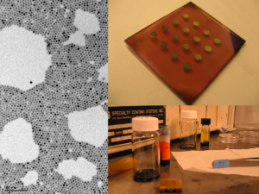Full-spectrum solar cells may reach 42 percent efficiency
June 26, 2011

Colloidal quantum dots are nanometer-sized semiconductor particles that are dispersed and processed into films from the solution phase (credit: U of Toronto)
University of Toronto engineering researchers have developed the first efficient tandem solar cell based on colloidal quantum dots (CQD). It may lead to inexpensive coatings that efficiently convert the sun’s rays to electricity.
The device is a stack of two light-absorbing layers — one tuned to capture the sun’s visible rays, the other to harvest the half of the sun’s power that lies in the infrared.
By capturing such a broad range of light waves — wider than normal solar cells — tandem CQD solar cells can in principle reach up to 42 percent efficiencies. The best single-junction solar cells are constrained to a maximum of 31 per cent efficiency; solar cells on the roofs of houses and in consumer products have 14 to 18 per cent efficiency.
Ref.: Edward H. Sargent, et al., Tandem colloidal quantum dot solar cells employing a graded recombination layer, Nature Photonics, 2011; [DOI: 10.1038/nphoton.2011.123]